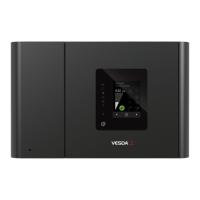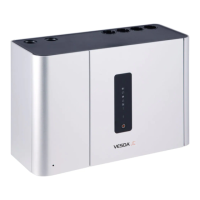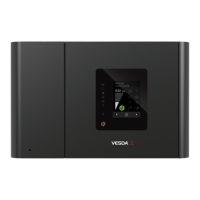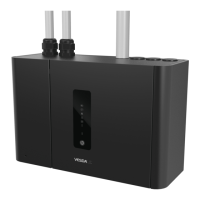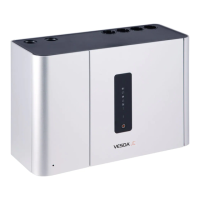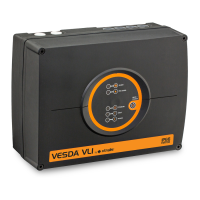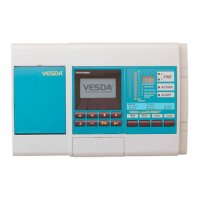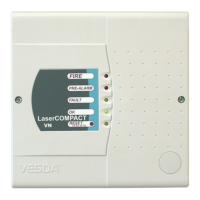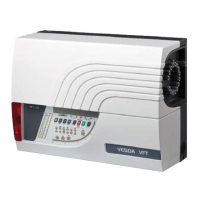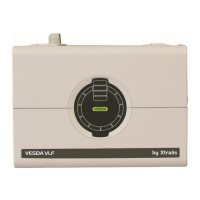Do you have a question about the Xtralis VESDA-E VES-A10-P and is the answer not in the manual?
Details the comprehensive features of the VESDA-E VES-A10-P detector, including sector addressability and advanced detection capabilities.
Identifies and describes the field-replaceable components of the VESDA-E VES-A10-P detector.
Explains the operational principle of the VESDA-E VES-A10-P, from air sampling to smoke detection.
Describes the front panel elements including status LEDs, buttons, and the touch screen interface.
Details the function and operation of the internal buttons, such as AutoConfig.
Explains the available physical and wireless ports for connecting and communicating with the detector.
Provides information on how the VESDA-E VES-A10-P integrates into a VESDAnet network.
Lists the detailed technical specifications of the VESDA-E VES-A10-P detector.
Provides the physical dimensions of the VESDA-E VES-A10-P detector in mm and inches.
Key points to consider when designing a pipe network for the VESDA-E VES-A10-P detector.
Important factors for the correct installation of sampling pipes and the detector.
Information on the tapered air inlet ports and pipe insertion.
Guidelines for managing the air expelled from the detector's exhaust port.
Steps to prepare the VESDA-E VES-A10-P detector before mounting.
Describes various methods for mounting the detector, including inversion and using brackets/templates.
Comprehensive guide to wiring the detector, including power, communication, and relay connections.
Procedure for powering up the VESDA-E VES-A10-P detector after installation.
A checklist to ensure all installation steps are completed before commissioning.
Steps for performing a preliminary check before the detector is commissioned.
Defines how to establish communication between Xtralis VSC and the detector.
Details methods for connecting the detector via USB, Ethernet, WiFi, and VESDAnet.
Describes password authentication for Ethernet/WiFi and user access levels.
Lists and explains commands that can be issued to the detector via buttons or software.
Provides an overview of various configuration settings available in Xtralis VSC.
Details the default values for detector parameters and their behavior on reset.
Introduction to the commissioning process and the AutoLearn function.
Explains the AutoLearn process for setting smoke thresholds based on the environment.
Details the AutoLearn process for setting airflow thresholds.
Procedure for verifying pipe network integrity and transport time with smoke.
Presents a schedule for routine maintenance checks for the VESDA-E VES-A10-P detector.
How to put the detector into standby mode for maintenance.
Instructions on how to open the front door for access to internal components.
Step-by-step guide for replacing the filter in the VESDA-E VES-A10-P.
Procedure for safely removing the front fascia, including ESD precautions.
Detailed instructions for removing and replacing the detector's aspirator.
Guide for removing and installing a new smoke detection chamber.
Procedure for removing and installing the sampling module.
Instructions for replacing the ultrasonics flow sensing and scanning module.
A list of available spare parts and their corresponding part numbers.
How detector faults are reported to external systems using relays.
Using front panel fault indicators to diagnose issues.
Utilizing Xtralis VSC to investigate and resolve detector faults.
Security measures to be implemented during the detector's commissioning phase.
Security guidelines for system maintenance and software updates.
Form to record the detector's configuration settings.
Form for recording ASPIRE modeling results for the system.
Form used to document the smoke test results.
Form for recording air sampling test results.
Provides definitions for technical terms used throughout the manual.
Details the comprehensive features of the VESDA-E VES-A10-P detector, including sector addressability and advanced detection capabilities.
Identifies and describes the field-replaceable components of the VESDA-E VES-A10-P detector.
Explains the operational principle of the VESDA-E VES-A10-P, from air sampling to smoke detection.
Describes the front panel elements including status LEDs, buttons, and the touch screen interface.
Details the function and operation of the internal buttons, such as AutoConfig.
Explains the available physical and wireless ports for connecting and communicating with the detector.
Provides information on how the VESDA-E VES-A10-P integrates into a VESDAnet network.
Lists the detailed technical specifications of the VESDA-E VES-A10-P detector.
Provides the physical dimensions of the VESDA-E VES-A10-P detector in mm and inches.
Key points to consider when designing a pipe network for the VESDA-E VES-A10-P detector.
Important factors for the correct installation of sampling pipes and the detector.
Information on the tapered air inlet ports and pipe insertion.
Guidelines for managing the air expelled from the detector's exhaust port.
Steps to prepare the VESDA-E VES-A10-P detector before mounting.
Describes various methods for mounting the detector, including inversion and using brackets/templates.
Comprehensive guide to wiring the detector, including power, communication, and relay connections.
Procedure for powering up the VESDA-E VES-A10-P detector after installation.
A checklist to ensure all installation steps are completed before commissioning.
Steps for performing a preliminary check before the detector is commissioned.
Defines how to establish communication between Xtralis VSC and the detector.
Details methods for connecting the detector via USB, Ethernet, WiFi, and VESDAnet.
Describes password authentication for Ethernet/WiFi and user access levels.
Lists and explains commands that can be issued to the detector via buttons or software.
Provides an overview of various configuration settings available in Xtralis VSC.
Details the default values for detector parameters and their behavior on reset.
Introduction to the commissioning process and the AutoLearn function.
Explains the AutoLearn process for setting smoke thresholds based on the environment.
Details the AutoLearn process for setting airflow thresholds.
Procedure for verifying pipe network integrity and transport time with smoke.
Presents a schedule for routine maintenance checks for the VESDA-E VES-A10-P detector.
How to put the detector into standby mode for maintenance.
Instructions on how to open the front door for access to internal components.
Step-by-step guide for replacing the filter in the VESDA-E VES-A10-P.
Procedure for safely removing the front fascia, including ESD precautions.
Detailed instructions for removing and replacing the detector's aspirator.
Guide for removing and installing a new smoke detection chamber.
Procedure for removing and installing the sampling module.
Instructions for replacing the ultrasonics flow sensing and scanning module.
A list of available spare parts and their corresponding part numbers.
How detector faults are reported to external systems using relays.
Using front panel fault indicators to diagnose issues.
Utilizing Xtralis VSC to investigate and resolve detector faults.
Security measures to be implemented during the detector's commissioning phase.
Security guidelines for system maintenance and software updates.
Form to record the detector's configuration settings.
Form for recording ASPIRE modeling results for the system.
Form used to document the smoke test results.
Form for recording air sampling test results.
Provides definitions for technical terms used throughout the manual.
| Model | VES-A10-P |
|---|---|
| Type | Aspirating Smoke Detector |
| Laser Class | Class 1 |
| IP Rating | IP40 |
| Detection Method | Laser-based |
| Detection Principle | Light Scatter |
| Air Sampling Type | Aspiration |
| Sensitivity Range | 0.005% obs/m to 20% obs/m |
| Max Coverage Area | 2000 m² |
| Alarm Levels | 4 |
| Air Flow Monitoring | Yes |
| Power Supply | 24 VDC |
| Operating Temperature | 0°C to 39°C |
| Operating Humidity | 10% to 95% RH (non-condensing) |
| Storage Temperature | -20°C to 60°C |
| Supply Voltage | 24 VDC |
| Communication Interface | Modbus |
| Weight | 8.8 lbs |
